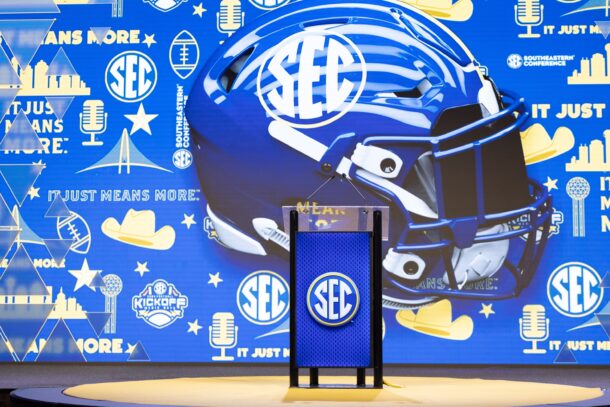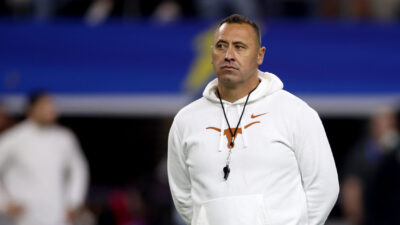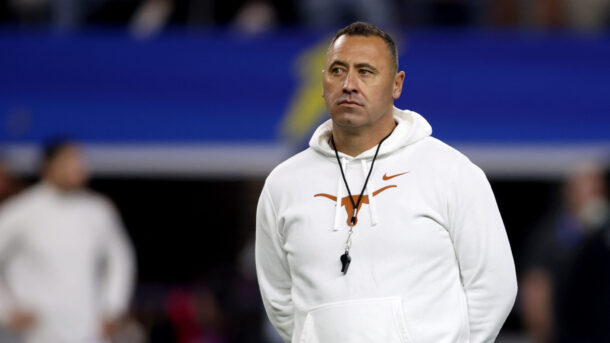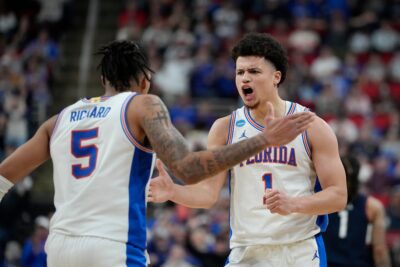Ad Disclosure
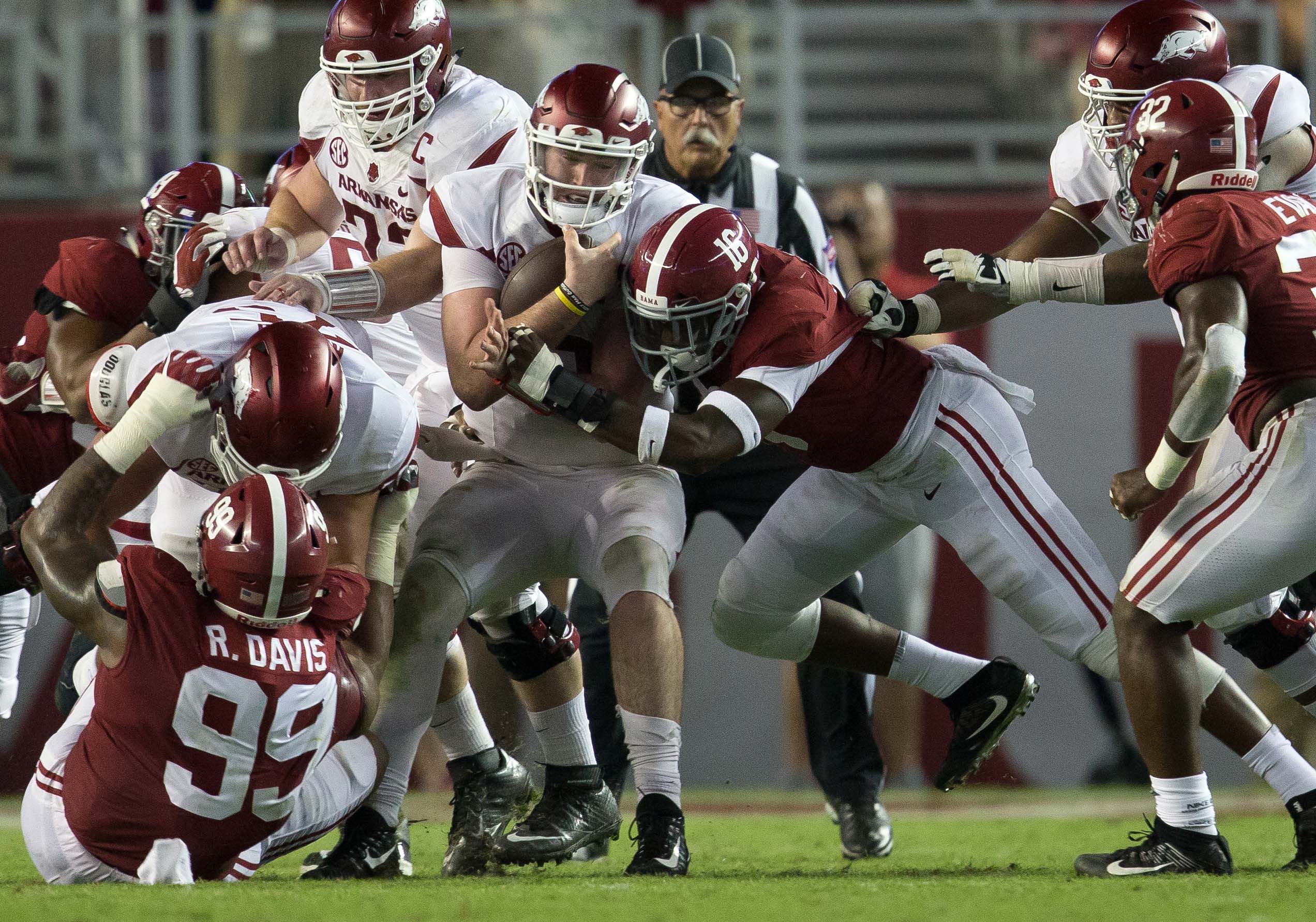
Monday Down South: Alabama’s reloaded pass rush is as terrifying as ever
By Matt Hinton
Published:
One of the major questions facing Alabama coming into the season — possibly the only major question, personnel-wise — was how the Crimson Tide would fare in replacing last year’s brigade of top-shelf pass rushers.
As talented as the Tide are along the front seven (and everywhere else), simply picking up with a new generation of 5-star prospects where the last group left off was hardly a foregone conclusion: For one thing, the outgoing class was highly decorated even by Bama standards, featuring two consensus All-Americans (Jonathan Allen and Reuben Foster) turned first-round draft picks and three others (Tim Williams, Ryan Anderson, and Dalvin Tomlinson) who were drafted in the first three rounds. Together, that quintet was a borderline NFL unit while still in college and a cornerstone of Bama’s back-to-back runs to the national title game.
For another, it represented a significant increase in pressure even compared to previous Alabama defenses under Nick Saban, notching more sacks that any other FBS defense in both 2015 and ’16. In Saban’s first eight years, the Tide only cracked the top 25 nationally in sacks once, in 2012, when they finished 16th. By that and every other measure, the departed front stood out in a way that made it uniquely difficult to replace regardless of who happened to be next in the pipeline.
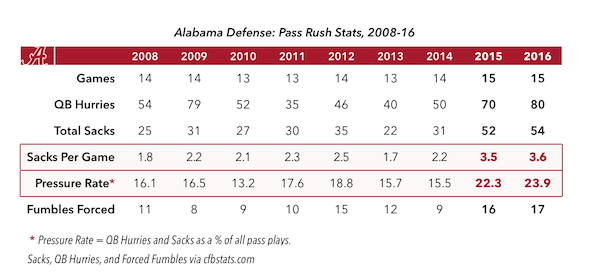
And initially, at least, the revamped 2017 front lagged predictably behind their most recent predecessors’ pace: Through four games this year Bama had just five sacks and only a handful of quarterback hurries. It had also suffered injuries to its most rusher, senior end Da’Shawn Hand, and two of its top three new outside linebackers, Christian Miller and Terrell Hall, both of whom were ruled out for the rest of the season. At midseason Alabama ranks 66th in Adjusted Sack Rate, almost exactly average among 130 FBS teams.
Over the past three games, though, the pass rush has begun to re-emerge with mostly new names delivering the same kind of production that fueled so much of the Crimson Tide’s front-line dominance that past two years.
Against Ole Miss, the Tide sacked the Rebels’ elusive quarterback, Shea Patterson, five times on top of 11 QB hurries. Against Texas A&M, they dropped the Aggies’ slippery freshman, Kellen Mond, four times. And in Saturday’s 41-9 win over Arkansas the front seven was a mainstay in the Razorbacks’ backfield, repeatedly and collectively pouncing on jumbo-sized quarterback Cole Kelley like a prowl of leopards taking down a wildebeest.

The final pressure line — five sacks, 11 hurries — was an exact repeat of the punishing performance against Ole Miss, and served as further confirmation that getting to the quarterback for the current group is likely to continue to be more of a collaborative effort without an individual headliner in the Allen mold: So far, Bama’s 19 sacks have been credited to 13 players, only one of whom (sophomore Raekwon Davis, with 4.5) has more than three.
The other players with multiple sacks include the starting middle linebackers (Shaun Dion Hamilton and Rashaan Evans) and a safety, Ronnie Harrison. That’s a very different look for a unit that, with Allen and Tomlinson on the line and Williams and Anderson off the edge, was accustomed to wreaking havoc with a minimum of blitzing.
But in almost every other way the current D is a carbon copy of the elite outfits the Tide have come to take for granted; on paper, they’re back among the top 10 nationally in total defense, scoring defense, rushing defense, pass efficiency defense and third-down defense, as always. If the pass rush is able to sustain its current pace with an almost entirely new cast, then it might be time to start thinking about their capacity for clobbering quarterbacks in the same automatic terms.
NOTEBOOK
Around the conference.
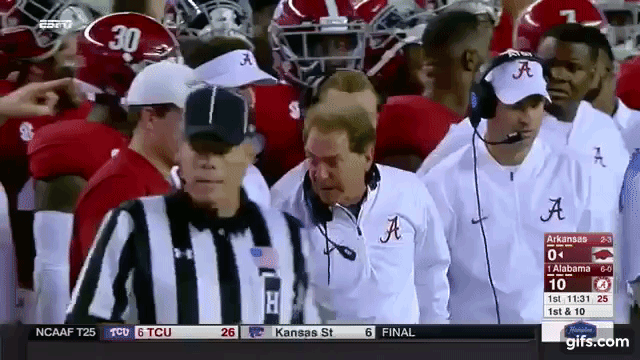
Alabama 41, Arkansas 9: Nick Saban has enlisted each of us to do our part to keep the Crimson Tide humble and hungry, and to that end I present this week’s Rat Poison Report on their myriad flaws and shortcomings in the course of a routine 32-point win over a division rival:
• Two muffed punts by true freshman returner Henry Ruggs III, one of which was recovered by Arkansas. (Appalling).
• Jalen Hurts’ first interception of the season, tainting the offense with a turnover for the second week in a row. (Truly shocking.)
• Three consecutive possessions in the first half ending in punts, including two three-and-outs. (Pitiful.)
• Six penalties, including a dead-ball personal foul against linebacker Mack Wilson. (Pathetic.)
• Fifteen first downs allowed by the defense, including five on third-down conversions and two on fourth down. (Unacceptable.)
• A garbage-time touchdown allowed by mostly reserve defenders on Arkansas’ last possession of the game. (Woeful.)
• With the Razorbacks’ late score they narrowly managed to cover the 35-point spread. (Failure to meet a clearly defined standard.)
This has been your weekly Rat Poison Report, please respect yourself and those around you by accepting nothing less than a relentless, single-minded pursuit of perfection in all aspects of your life.
In other news, on Damien Harris’ 75-yard touchdown run to open the game a cutback lane opened up wide enough to comfortably accommodate at least nine Damien Harrises:

If anything, the weekend’s rash of upsets around the country puts the Tide’s insane consistency into perspective: Where four other Top-10 teams were ambushed by unranked, double-digit underdogs, Bama effortlessly extended its winning streak over unranked teams to 71 straight dating back to 2007, Saban’s first season.
LSU 27, Auburn 23: Auburn went up 20-0 less than 20 minutes into this game, and given what we knew about these two teams coming in it should have only gotten worse from there. Over the previous three weeks we’d seen Auburn get off to the same kind of lightning-fast start against Missouri (28-0 in the second quarter), Mississippi State (21-3), and Ole Miss (35-3) en route to lopsided, momentum-building wins; in the same span LSU was blown out in Starkville, lost to a Sun Belt team, and barely fended off another mediocre version of Florida.
Everything about their respective trajectories pointed toward a banner year for Auburn, on par with the Tigers’ best under Gus Malzahn, and the worst-case scenario for LSU after promoting Ed Orgeron full-time.
At that point, how was LSU even going to score 20 points? What the heck happened?
The most obvious answer is that Jarrett Stidham simply fell apart: On Auburn’s first four possessions, he was 6-of-8 for 144 yards and a touchdown; from that point on, he finished 3-of-18 for 21 yards, ending the game with a single completion (for no gain) in his last dozen attempts. But there was also the fact that Auburn effectively shifted into bunker mode with three-quarters of the game left to play: Between the end of the first quarter, after Auburn had extended its lead to three scores, and the final few minutes of the fourth, after the Tigers had fallen behind for the first time, Malzahn and offensive coordinator Chip Lindsey called for runs to either Kerryon Johnson or Kamryn Pettway on 17 consecutive first-down plays.
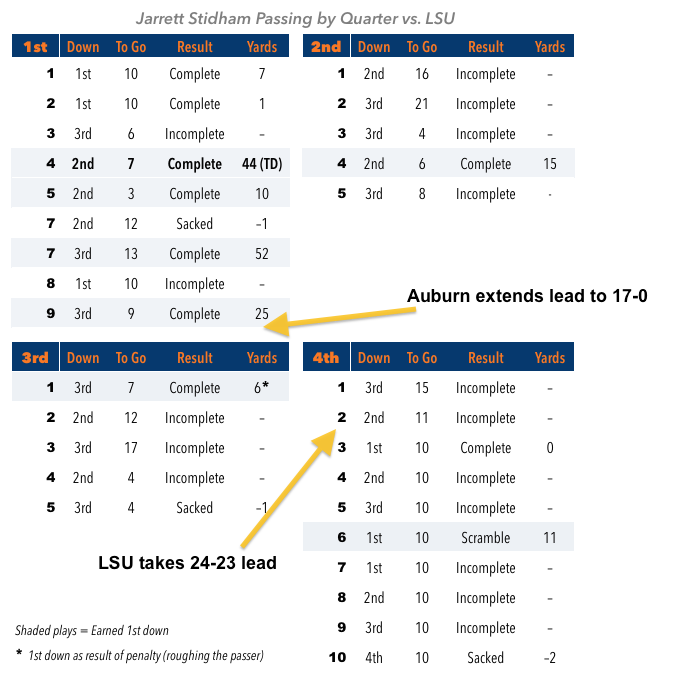
For a coach once defined by his unorthodox, pedal-to-the-metal philosophy, that’s worse than “conservative”: It’s downright stale. It would be one thing if the Tigers were running at will, as they more or less did in their previous three wins, or if Stidham was more than an afterthought in the zone read game, which Malzahn’s offenses have deployed to such devastating effecting the past.
By halftime on Saturday, though, it was clear LSU had drawn a bead on the ground game, at which point continuing to bang away on first down only served to make Stidham’s job harder when Auburn was forced to throw on second- and third-and-long. (Presumably it didn’t help that, according to Stidham, he doesn’t have permission from coaches to audible out of the called play based on the defense.)
Either Malzahn and Lindsey didn’t trust their quarterback enough to keep the playbook open in a hostile environment — a distinct possibility, in the wake of the Clemson debacle in Week 2 — or they trusted their defense and running game way too much.
Either way, it’s a lot harder today to project Auburn as a viable threat to Alabama in the West than it was 72 hours ago. Technically, the Tigers still control their destiny, and should still be favored to win their next two games (at Arkansas and Texas A&M) ahead of a Nov. 11 date with Georgia; win all three, and the Iron Bowl sets up as a winner-take-all for the division. Realistically, odds of beating UGA or Bama — much less both of them — look even longer now than they did after the meltdown at Clemson.
The offense we saw over the last three quarters in Baton Rouge was the same one we saw flop last month against the defending champs. The stakes a month from now won’t be any more forgiving.
Texas A&M 19, Florida 17: At the end of the third quarter, Florida QB Feleipe Franks embarked on what may be the longest run in school history, at least in terms of total time elapsed — 17 seconds from start to finish, a play so sprawling it barely fits in a single gif — and was certainly the most exhausting. That goes for everyone involved, including Franks himself, all 86,000 in attendance, and the entire national viewing audience.
But it goes especially for this week’s “Fat Guy of the Week,” Kingsley Keke, a 6-foot-3, 319-pound defensive tackle who appeared to be out of the play from the start, yet kept hustling until he somehow managed to chug his way into position to make a touchdown-saving tackle more than 80 yards (!) from where he started.
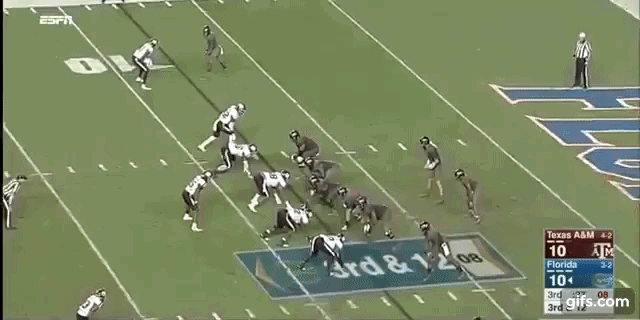
Florida turned the big gain into points anyway, ensuring Keke’s effort went for naught with a 6-yard TD run by Dre Massey a couple plays later. (The Gators didn’t threaten again as A&M rallied for its third fourth-quarter comeback in the past four weeks.) But if that’s not a record for “longest gain on a solo tackle by an interior lineman” I demand to see the play that beats it out immediately.
Georgia 53, Missouri 28: We’re officially at the point that Georgia gashing a division opponent for 370 yards rushing on 7.3 per carry hardly seems notable, except as an excuse to show Nick Chubb hurtling a dude in the open field, followed by D’Andre Swift hurdling another dude. (At one point in this game even the backup tight end hurdled a dude. It was that kind of night.) Between Chubb, Swift, Sony Michel, and the rest of their five-deep running back rotation, UGA went over 300 yards on the ground (not including sacks) for the third week in a row while also — oh by the way — more than doubling its season average through the air.
Altogether, 53 points marked Georgia’s best output against an SEC opponent in almost three years, since a 2014 win over Kentucky; given what we already knew about Missouri’s defense and the Bulldogs’ steady upward trend on the scoreboard over the past six weeks, it felt very routine.
For the first time this year, the same can’t quite be said for the defense, which gave up more touchdown passes to beleaguered Mizzou QB Drew Lock (4) than it had allowed in its previous six games combined (3).
The first and last of throws probably don’t have any bearing on anything going forward — the first came on a short field following a UGA turnover, the last in garbage time. In between, though, Lock connected on a pair of 63-yard scoring bombs to Emanuel Hall on back-to-back possessions in the first half, the first hints of vulnerability we’ve seen from the Georgia defense in a game that’s still in doubt.
Lock is the first quarterback the Bulldogs have faced with that kind of deep arm strength; otherwise, they were fine. But the next three QBs on the schedule (Florida’s Franks, South Carolina’s Jake Bentley and Auburn’s Stidham) can all conceivably challenge the secondary in the same way. Just a small note to file away for later.
SUPERLATIVES
The best of the week…
https://www.youtube.com/watch?v=qKh4ihusiF4
D.J. Chark, WR/PR, LSU. Chark had five catches for 150 yards in LSU’s come-from-behind win over LSU, plus the biggest play of the game: A 75-yard punt return to pull LSU within one score early in the fourth quarter. His 233 all-purpose yards more than doubled his previous career high against an FBS opponent.
Devin White, LB, and Grant Delpit, DB, LSU. On the defensive side, top honors are split between White, a sophomore, and Delpit, a true freshman, who combined for 23 total tackles, 3.5 tackles for loss, two passes broken up, and one QB hurry in the course of cracking down on Auburn’s offense over the final three quarters.
Rashaan Evans, LB, Alabama. Evans, a senior, was credited with four of the Crimson Tide’s nine TFLs against Arkansas and two of its 11 QB hurries, as close as any member of the Bama front seven has comes this year to a breakout performance. That statement ought to last for, oh, another six days or so before another new blue-chip statement makes his case against Tennessee’s ailing offensive line.
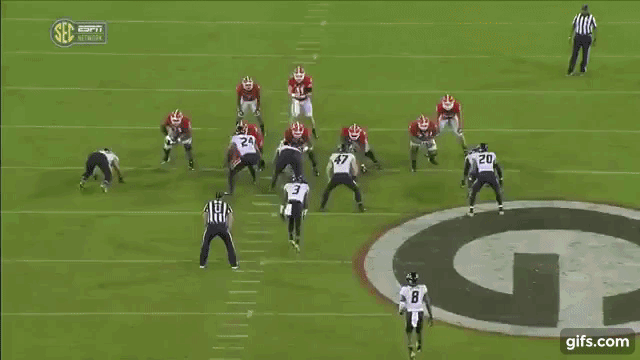
Mecole Hardman, WR/KR, Georgia. Hardman scored Georgia’s first touchdown against Missouri, courtesy of a 35-yard end around in the first quarter, and its last, on a 59-yard catch-and-run TD that slammed the door shut in the fourth. In retrospect, moving him from defense is beginning to look like a pretty good idea.
D.J. Wonnum, DE, South Carolina. Wonnum was credited with six solo tackles and two sacks in Carolina’s 15-9 win over Tennessee, playing a leading role in stifling the Vols for the majority of the afternoon and managing to hold them out of the end zone even when they weren’t. (See below).
Taven Bryan, DL, Florida. Bryant was unblockable for stretches of the Gators’ loss to Texas A&M, finishing with seven total tackles and a pair of sacks in a largely dominant effort by the Florida defense. It marked the second straight game the Gators have lost while holding the opposing offense below 20 points, both of them at home.
Catch of the Year of the Week: D.K. Metcalf, Ole Miss: Ole Miss’ offense took out its many frustrations on Vanderbilt’s secondary, bombing the Commodores for 351 yards and four touchdowns through the air alone en route to a wild, 57-35 win in Oxford. But nothing else in that barnburner brought the house down like Metcalf’s 34-yard, Prothro-esque grab off the back of Tre Herndon’s helmet in the second quarter:
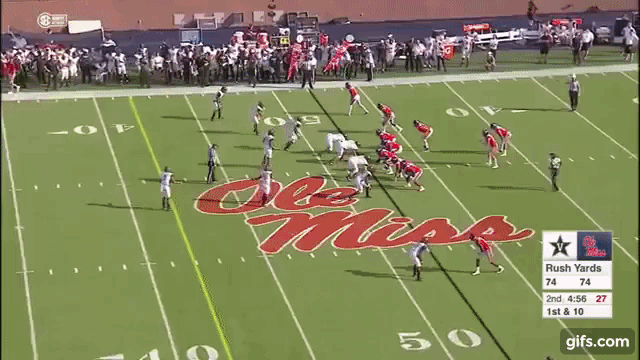
When it’s on, as it was Saturday, Ole Miss’ passing game is a sight to behold. Let’s hope that’s more often over the second half of the season than it was in the first.
Honorable Mention: Full-extension grabs in Baton Rouge by Auburn’s Ryan Davis and LSU’s Russell Gage Jr.
DEMERITS
… and the worst.
Arkansas’ Botched Punt. How many ways can a simple punt go wrong? Let’s count!
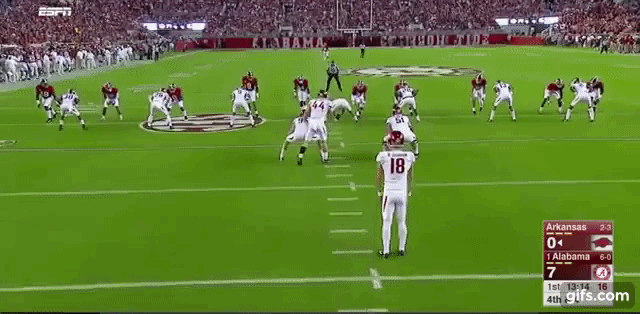
1. The snap. Actually, the snap itself was fine — just a tad to punter Blake Johnson’s right, maybe, but nothing he should have had any problem handling. He did, though, letting the ball slip right through his hands. The rest of the play was downhill from there.
2. The throw. As bad as it seemed, Johnson still had a chance to salvage something at least roughly resembling a normal rugby punt from disaster: By the time he recovered the loose ball at his own 1-yard line, there wasn’t an Alabama player within 15 yards.

That’s enough room to get off a kick, even if it was a shank under duress; at that point, a bad punt would have been better than no punt. Instead, Johnson panicked and launched a futile, off-balance heave with no chance of success.
3. The penalty. The ad-libbed throw also prompted a flag against Arkansas for an illegal man downfield, because of course it did. (The Crimson Tide declined the penalty, which would have given Arkansas the chance to replay the down, because of course they did.)
4. The timing. Less than two minutes into the game, the Razorbacks — 37-point underdogs starting a backup QB on the road, a week after giving up three non-offensive TDs in a demoralizing loss at South Carolina — had already allowed a long touchdown run on Bama’s first play of the game and responded by going three-and-out on their opening series. There was never any realistic hope for an upset, but whatever kind of fight Bret Bielema hoped his team would put up was reduced to a fight for survival almost before ESPN could cut to the game from the Oklahoma-Texas thriller that preceded it. If only the Sooners and Longhorns had gone to overtime.
Tennessee in the Red Zone. The Vols’ repeated failure to turn prime scoring opportunities into actual points cost them dearly in their Sept. 16 loss to Florida, and bit them hard, again, in their loss to South Carolina:
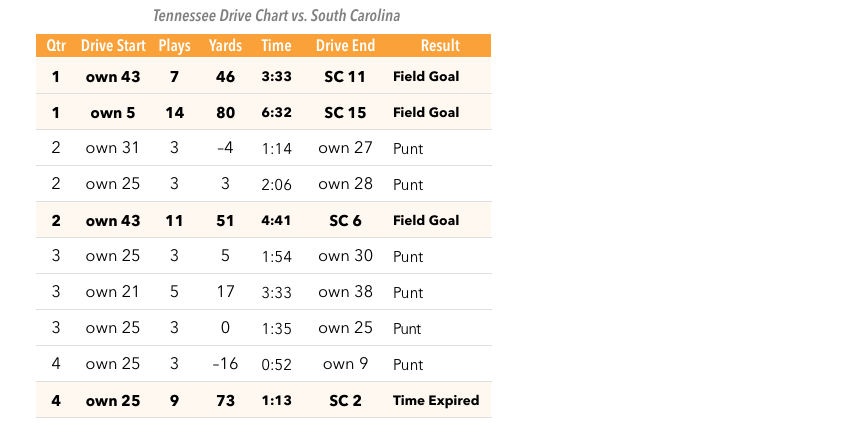
That comes out to nine points on four trips inside the Gamecocks’ 15-yard line, bringing Tennessee’s overall red-zone record in SEC play to zero touchdowns on seven attempts. John Kelly is working way too hard for those kinds of returns.
In this case, those were also the Vols’ only sustained drives of the game — their other six possessions yielded just one first down, and (unlike the loss in Gainesville) they never threatened to break a big play from further out. For an offense that struggles to generate big plays in general, finishing off the few chances it manages to create for itself is turning out to be quite literally the difference between winning and losing.
Florida’s Swamp Gas Uniforms. The worst. Ever.
#Gators unveiled their new Swampy alternate unis last night. My mentions were displeased. https://t.co/RtkEEHDjQe
— Matt Baker (@MBakerTBTimes) October 10, 2017
Evacuate the premises.
Florida will wear the worst uniforms in the history of Western civilization on Saturday. https://t.co/neylR4LkEq
— Zach Barnett (@zach_barnett) October 10, 2017
Send in teams of highly trained specialists outfitted head-to-toe in biohazard suits to dispose of their remains.
Florida should be forced to forfeit the game because of these uniforms. pic.twitter.com/WnnKDbPy9y
— Andrew Siciliano (@AndrewSiciliano) October 15, 2017
Burn them.
You still have 24 hours to rethink these uniforms, Florida … https://t.co/vLo9v8C6iU
— SI College Football (@si_ncaafb) October 13, 2017
Scatter their ashes at sea.
I love when #Florida wears white on white, blue on blue, orange on orange or any mix of those, but today’s uniforms are awful. pic.twitter.com/ATrm5pGu7G
— ChadSimmons (@ChadSimmons_) October 14, 2017
Eradicate all evidence of their existence.
Florida deserved to lose in these uniforms and will thankfully never wear them again https://t.co/VGz1yy5pyq
— Sports internet (@Sportsinternet1) October 15, 2017
Let us never speak of them again.
Matt Hinton, author of 'Monday Down South' and our resident QB guru, has previously written for Dr. Saturday, CBS and Grantland.
